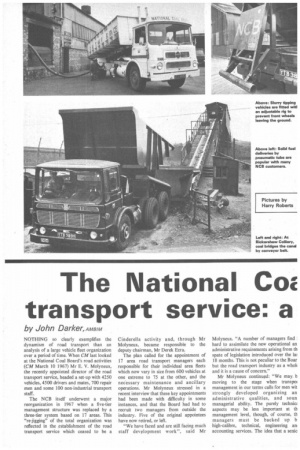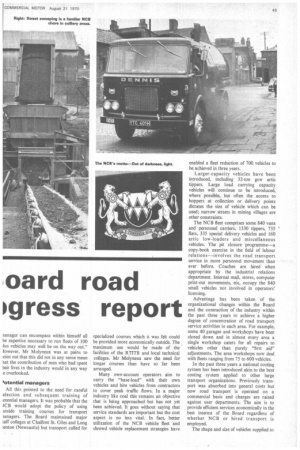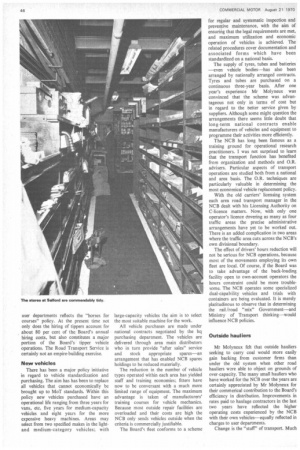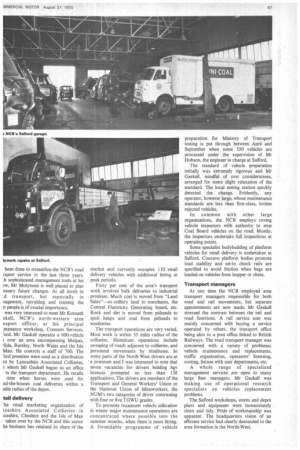The National Cog oard road transport service: a ogress report
Page 46

Page 47

Page 48

Page 49

If you've noticed an error in this article please click here to report it so we can fix it.
NOTHING so clearly exemplifies the dynamism of road transport than an analysis of a large vehicle fleet organization over a period of time. When CM last looked at the National Coal Board's road activities (CM March 10 1967) Mr E V. Molyneux, the recently appointed director of the road transport service, headed a set-up with 4250 vehicles, 4500 drivers and mates, 700 repair men and some 100 non-industrial transport staff.
The NCB itself underwent a major reorganization in 1967 when a five-tier management structure was replaced by a three-tier system based on 17 areas. This "re-jigging" of the total organization was reflected in the .establishment of the road transport service which ceased to be a Cinderella activity and, through Mr Molyneux, became responsible to the deputy chairman, Mr Derek Ezra.
The plan called for the appointment of 17 area road transport managers each responsible for their individual area fleets which now vary in size from 600 vehicles at one extreme to 75 at the other, and the necessary maintenance and ancillary operations. Mr Molyneux stressed in a recent interview that these key appointments had been made with difficulty in some instances, and that the Board had had to recruit two managers from outside the industry. Five of the original appointees have now retired, or left.
"We have faced and are still facing much staff development work", said Mr
Molyneux. "A number of managers find hard to assimilate the new operational an administrative requirements arising from th spate of legislation introduced over the la:. 18 months. This is not peculiar to the Boar but the road transport industry as a wholl and it is a cause of concern.
Mr Molyneux continued: "We may moving to the stage when transpoi management in our terms calls for men wit strongly developed organizing an administrative qualities, and soun managerial ability. The purely technic: aspects may be less important at th management level, though, of course, th managers must be backed up b high-calibre, technical, engineering an accounting services. The idea that a senic tanager can encompass within himself all he expertise necessary to run fleets of 100 his vehicles may well be on the way out." lowever, Mr Molyneux was at pains to oint out that this did not in any sense mean hat the contribution of men who had spent heir lives in the industry would in any way e overlooked.
lotential managers
All this pointed to the need for careful election and subsequent training of otential managers. It was probable that the ICB would adopt the policy of using utside training courses for transport tanagers. The Board maintained major tail colleges at Chalfont St. Giles and Long ;enton (Newcastle) but transport called for specialized courses which it was felt could be provided more economically outside. The , maximum use would be made of the facilities of the RIM and local technical colleges. Mr Molyneux saw the need for longer courses than have so far been arranged.
Many own-account operators aim to carry the "base-load" with their own vehicles and hire vehicles from contractors to cover peak traffic flows. In a major industry like coal this remains an objective that is being approached but has not yet been achieved. It goes without saying that service standards are important but the cost aspect is no less vital. In fact, better utilization of the NCB vehicle fleet and shrewd vehicle replacement strategies have enabled a fleet reduction of 700 vehicles to be achieved in three years.
Larger-capacity vehicles have been introduced, including 32-ton gcw artic tippers. Large load carrying capacity vehicles will continue to be introduced, where possible, but often the access to hoppers at collection or delivery points dictates the size of vehicle which can be used; narrow streets in mining villages are other constraints.
The NCB fleet comprises some 840 vans and personnel carriers, 1330 tippers, 735 flats, 335 special delivery vehicles and 160 artic low-loaders and miscellaneous vehicles. The pit closure programme—a copy-book exercise in the field of labour relations--involves the road transport service in more personnel movement than ever before. Coaches are hired when appropriate by the industrial relations department. Internal mail, stores, computer print-out movements, etc, occupy the 840 small vehicles not involved in operators' licensing.
Advantage has been taken of the organizational changes within the Board and the contraction of the industry within the past three years to achieve a higher degree of concentration of road transport service activities in each area. For example, some 40 garages and workshops have been closed down and in almost every area a single workshop caters for all repairs to vehicles other than purely "first aid" adjustments. The area workshops now deal with fleets ranging from 75 to 600 vehicles.
In the past three years a national costing system has been introduced akin to the best costing system applied to other large transport organizations. Previously transport was absorbed into general costs but now road transport is operated on a commercial basis and charges are raised against user departments. The aim is to provide efficient services economically in the best interest of the Board regardless of whether NCB or hired transport is employed.
The shape and size of vehicles supplied to user departments reflects the "horses for courses" policy. At the present time not only does the hiring of tippers account for about 80 per cent of the Board's annual hiring costs, but also constitutes a major portion of the Board's' tipper vehicle operations. The Road Transport Service is certainly not an empire-building exercise.
New vehicles There has been a major policy initiative in regard to vehicle standardization and purchasing. The aim has has been to replace all vehicles that cannot economically be brought up to MoT standards. Within this policy new vehicles purchased have an operational life ranging from three years for vans, etc, five years for medium-capacity vehicles and eight years for the more expensive heavy machines. Areas may select from two specified makes in the lightand medium-category vehicles; with large-capacity vehicles the aim is to select the most suitable machine for the work.
All vehicle purchases are made under national contracts negotiated by the hq purchasing department. The vehicles are delivered through area main distributors who in turn provide "after sales" service and stock appropriate spares—an arrangement that has enabled NCB spares holdings to be reduced materially.
The reduction in the number of vehicle types operated within each area has yielded staff and training economies; fitters have now to be conversant with a much more limited range of equipment. The maximum advantage is taken of manufacturers' training courses for vehicle mechanics. Because most outside repair facilities are overloaded and their costs are high the NCB only sends vehicles outside when the criteria is commercially justifiable.
The Board's fleet conforms to a scheme for regular and systematic inspection and preventive maintenance, with the aim of ensuring that the legal requirements are met, and maximum utilization and economic operation of vehicles is achieved. The related procedures cover documentation and associated forms which have been standardized on a national basis.
The supply of tyres, tubes and batteries —even vehicle bodies—has also been arranged by nationally arranged contracts. Tyres and tubes are purchased on a continuous three-year basis. After one year's experience Mr Molyneux was convinced that the scheme was advantageous not only in terms of cost but in regard to the better service given by suppliers. Although some might question the arrangements there seems little doubt that long-term national contracts enable manufacturers of vehicles and equipment to programme their activities more efficiently.
The NCB has long been famous as a training ground for operational research practitioners. I was not surprised to learn that the transport function has benefited from organization and methods and O.R. advisers. Particular aspects of transport operations are studied both from a national and area basis. The O.R. techniques are particularly valuable in determining the most economical vehicle replacement policy.
With the old carriers' licensing system each area road transport manager in the NCB dealt with his Licensing Authority on C-licence matters. Now, with only one operator's licence Covering as many as four traffic areas the precise administrative arrangements have yet to be worked out. There is an added complication in two areas where the traffic area cuts across the NCB's own divisional boundary.
The effect of drivers' hours reduction will not be serious for NCB operations, because most of the movements employing its own fleet are local. Of course, if the Board was to take advantage of the back-loading facility open to own-account operators the hours constraint could be more troublesome. The NCB operates some specialized dual-capability vehicles and trials with containers are being evaluated. It is merely platitudinous to observe that in determining the rail /road "mix" Government—and Ministry of Transport thinking—would influence NCB policies.
Outside hauliers
Mr Molyneux felt that outside hauliers seeking to carry coal would more easily gain backing from customer firms than under the old system when other road hauliers were able to object on grounds of over-capacity. The many small hauliers who have worked for the NCB over the years are certainly appreciated by Mr Molyneux for their commerical contribution to the Board's efficiency in distribution. Improvements in rates paid to haulage contractors in the last two years have reflected the higher operating costs experienced by the NCB with their own vehicles—equally reflected in charges to user departments.
Change is the "stuff" of transport. Much been done to streamline the NCB's road isport service in the last three years. :h sophisticated management tools at his )w, Mr Molyneux is well placed to plan essary future changes. At all levels in Ld transport, but especially in nagement, recruiting and training the it people is of crucial importance.
was very interested to meet Mr Kenneth skell. NCB's north-western area nsport officer, at his principal intenance workshop, Crescent Services, Ford. Mr Gaskell operates a 600-vehicle t over an area encompassing Malpas, lisle, Burnley. North Wales and the Isle Man. He controls a staff of 700. The Ford premises were used as a distribution ot by Lancashire Associated Collieries, whom Mr Gaskell began as an office in the transport department. He recalls time when horses were used for nd-the-houses coal deliveries within a mile radius of the depot.
tail delivery he retail marketing organization of icashire Associated Collieries in icashire, Cheshire and the Isle of Man taken over by the NCB and this sector he business has retained its share of the market and currently occupies 110 retail delivery vehicles with additional hiring at peak periods.
Forty per cent of the area's transport work involves bulk deliveries to industrial premises. Much coal is moved from "Land Sales"—ex-colliery land to merchants, the Central Electricity Generating board, etc. Rock and dirt is moved from pitheads to spoil heaps and coal from pitheads to washieries.
The transport operations are very varied. Most work is within 35 miles radius of the collieries. Humdrum operations include sweeping of roads adjacent to collieries, and personnel movements by minibuses. In some parts of the North-West drivers are at a premium and I was interested to note that seven vacancies for drivers holding hgv licences prompted no less than 138 applications. The drivers are members of the Transport and General Workers' Union or the National Union of Mineworkers, the NUM's two categories of driver contrasting with four or five TGWU grades.
To promote maximum vehicle utilization in winter major maintenance operations are concentrated where possible into the summer months, when there is more hiring. A formidable programme of vehicle preparation for Ministry of Transport testing is put through between April and September when some 350 vehicles are processed under the supervision of Mr Hobson. the engineer in charge at Salford.
The standard of vehicle preparation initially was extremely rigorous and Mr Gaskell, mindful of cost considerations, arranged for some slight relaxation of the standard. The local testing station quickly detected the change. Evidently, any operator. however large, whose maintenance standards are less than first-class, invites rejected vehicles.
In common with other large organizations, the NCB employs roving vehicle inspectors with authority to stop Coal Board vehicles on the road. Mostly, the inspectors undertake full inspections at operating points.
Some specialist bodybuilding of platform vehicles for retail delivery is undertaken at Salford. Concave platform bodies promote load stability and set-in chock rails are specified to avoid friction when bags are loaded on vehicles from hopper or chute.
Transport managers At one time the NCB employed area transport managers responsible for both road and rail movements, but separate appointments are now made. Mr Gaskell stressed the contrast between the rail and road functions. A rail service user was mainly concerned with buying a service operated by others, the transport office being akin to a post office linked to British Railways. The road transport manager was concerned with a variety of problems; vehicle maintenance and replacements, traffic organization, operators' licensing, costing, liaison with user departments, etc.
A whole range of specialized management services are open to many large fleet managers. Mr Gaskell was making use of operational research specialists on vehicles replacement problems.
The Salford workshops, stores and depot plant and equipment were immaculately clean and tidy. Pride of workmanship was apparent. The headquarters vision of an efficient service had clearly descended to the area formation in the North-West.














































































































